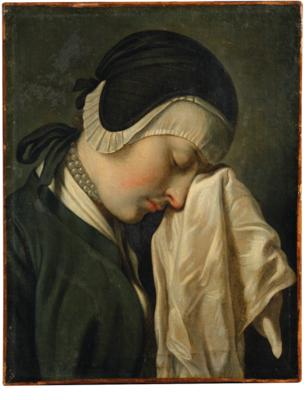Pietro Rotari
(Verona 1707–1762 Saint Petersburg)
A young woman crying,
oil on canvas, 46 x 36 cm, framed
Provenance:
possibly collection of Paolo Rotari, the artist’s brother, Verona;
possibly thence by descent to his son;
Estate Félicien (according to an inscription on the reverse);
acquired in Venice, 1834 (according to an inscription on the reverse);
art market, Italy;
where acquired by the present owner
We are grateful to Enrico Lucchese for endorsing the attribution of the present painting and for his help in cataloguing this lot.
The present painting bears inscriptions on the reverse, which refer to its Venetian provenance, before 1834 and it is possible that this painting originally belonged to a group of portraits and genre figures in half-length, inherited by the painter’s brother Paolo in Verona, which was dispersed soon after the death of Paolo’s son in 1831 (see P. Delorenzi, in: F. Magani et al. [eds.], Il Settecento a Verona. Tiepolo Cignaroli Rotari, la nobiltà della pittura, Milan 2011, p. 212).
Rotari’s production of figures in half-length, especially women, always presenting differing and varied emotions, is documented from as early as the summer of 1749, when Scipione Maffei of Verona records in his collection a ‘donna piangente’ [‘crying woman’] and another ‘sorridente’ [‘smiling’] (see S. Maffei, Epistolario (1700–1755), ed. by C. Garibotto, II, Milan 1955, p. 1248). It was only later, during his sojourns at the courts of Vienna and Dresden that Rotari began consistently producing this type of paintings, which are stylistically close to the pastels of Rosalba Carriera and Jean-Etienne Liotard, which were similarly collected by his aristocratic patrons.
Rotari’s success in Poland at the court of Augustus III was followed by his summons to Saint Petersburg in 1756 by the Russian Empress Elizaveta Petrovna. Some forty paintings left in his studio in Russia were returned to his brother Paolo in Verona, while another thirty-two canvases were inherited by Catherine II. In 1764 she commissioned 360 ‘character portraits’ for the decoration of the Cabinet of the Muses and Graces at the Peterhof Palace. The present painting relates to a variant in the Galleria Nazionale d’Arte Antica, Rome, which probably dates to the artist’s Russian period.
The present work, with its bright, luminous palette and refined brush work anticipates a rise of neoclassical sensibilities which might be traced to the publication of ‘Thoughts on the Imitation of Greek Works in Painting and Sculpture’ by Johann Joachim Winckelmann in 1755, which coincided with the last year of Rotari’s residence in Dresden.
Specialist: Mark MacDonnell
 Mark MacDonnell
Mark MacDonnell
+43 1 515 60 403
mark.macdonnell@dorotheum.at
25.10.2023 - 18:00
- Estimate:
-
EUR 30,000.- to EUR 40,000.-
Follow Remove
Pietro Rotari
(Verona 1707–1762 Saint Petersburg)
A young woman crying,
oil on canvas, 46 x 36 cm, framed
Provenance:
possibly collection of Paolo Rotari, the artist’s brother, Verona;
possibly thence by descent to his son;
Estate Félicien (according to an inscription on the reverse);
acquired in Venice, 1834 (according to an inscription on the reverse);
art market, Italy;
where acquired by the present owner
We are grateful to Enrico Lucchese for endorsing the attribution of the present painting and for his help in cataloguing this lot.
The present painting bears inscriptions on the reverse, which refer to its Venetian provenance, before 1834 and it is possible that this painting originally belonged to a group of portraits and genre figures in half-length, inherited by the painter’s brother Paolo in Verona, which was dispersed soon after the death of Paolo’s son in 1831 (see P. Delorenzi, in: F. Magani et al. [eds.], Il Settecento a Verona. Tiepolo Cignaroli Rotari, la nobiltà della pittura, Milan 2011, p. 212).
Rotari’s production of figures in half-length, especially women, always presenting differing and varied emotions, is documented from as early as the summer of 1749, when Scipione Maffei of Verona records in his collection a ‘donna piangente’ [‘crying woman’] and another ‘sorridente’ [‘smiling’] (see S. Maffei, Epistolario (1700–1755), ed. by C. Garibotto, II, Milan 1955, p. 1248). It was only later, during his sojourns at the courts of Vienna and Dresden that Rotari began consistently producing this type of paintings, which are stylistically close to the pastels of Rosalba Carriera and Jean-Etienne Liotard, which were similarly collected by his aristocratic patrons.
Rotari’s success in Poland at the court of Augustus III was followed by his summons to Saint Petersburg in 1756 by the Russian Empress Elizaveta Petrovna. Some forty paintings left in his studio in Russia were returned to his brother Paolo in Verona, while another thirty-two canvases were inherited by Catherine II. In 1764 she commissioned 360 ‘character portraits’ for the decoration of the Cabinet of the Muses and Graces at the Peterhof Palace. The present painting relates to a variant in the Galleria Nazionale d’Arte Antica, Rome, which probably dates to the artist’s Russian period.
The present work, with its bright, luminous palette and refined brush work anticipates a rise of neoclassical sensibilities which might be traced to the publication of ‘Thoughts on the Imitation of Greek Works in Painting and Sculpture’ by Johann Joachim Winckelmann in 1755, which coincided with the last year of Rotari’s residence in Dresden.
Specialist: Mark MacDonnell
 Mark MacDonnell
Mark MacDonnell
+43 1 515 60 403
mark.macdonnell@dorotheum.at
|
Buyers hotline
Mon.-Fri.: 10.00am - 5.00pm
old.masters@dorotheum.at +43 1 515 60 403 |
| Auction: | Old Masters |
| Auction type: | Saleroom auction with Live Bidding |
| Date: | 25.10.2023 - 18:00 |
| Location: | Vienna | Palais Dorotheum |
| Exhibition: | 14.10. - 25.10.2023 |

